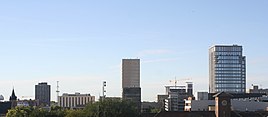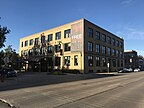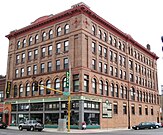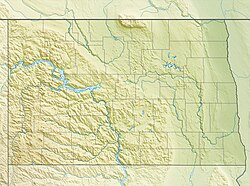
A | B | C | D | E | F | G | H | CH | I | J | K | L | M | N | O | P | Q | R | S | T | U | V | W | X | Y | Z | 0 | 1 | 2 | 3 | 4 | 5 | 6 | 7 | 8 | 9
Fargo, North Dakota | |
|---|---|
City | |
Downtown Fargo Veterans Memorial Bridge | |
| Coordinates: 46°52′24″N 96°49′38″W / 46.87333°N 96.82722°W | |
| Country | United States |
| State | North Dakota |
| County | Cass |
| Founded | 1871 |
| Named for | William Fargo |
| Government | |
| • Mayor | Tim Mahoney (D) |
| Area | |
| • City | 50.77 sq mi (131.49 km2) |
| Elevation | 906 ft (276 m) |
| Population | |
| • City | 125,990 |
| • Estimate (2022)[5] | 131,444 |
| • Rank | US: 216th ND: 1st |
| • Density | 2,481.68/sq mi (958.19/km2) |
| • Urban | 216,214 (US: 178th)[2] |
| • Urban density | 2,781.6/sq mi (1,074.0/km2) |
| • Metro | 258,663 (US: 190th) |
| • Demonym | Fargoan |
| Time zone | UTC-6 (Central) |
| • Summer (DST) | UTC-5 (CDT) |
| ZIP Codes | 58102–58109, 58121–58122, 58124–58126 |
| Area code | 701 |
| FIPS code | 38-25700 |
| GNIS feature ID | 1036030[3] |
| Website | fargond.gov |
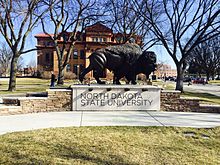
Fargo is a city in and the county seat of Cass County, North Dakota, United States. According to the 2020 census, its population was 125,990,[4] making it the most populous city in the state and the 216th most populous city in the United States. Fargo, along with its twin city of Moorhead, Minnesota, and the adjacent cities of West Fargo, North Dakota and Dilworth, Minnesota, form the core of the Fargo–Moorhead, ND-MN Metropolitan Statistical Area (MSA). The MSA had a population of 248,591 in 2020.
Fargo was founded in 1871 on the Red River of the North floodplain.[6] It is a cultural, retail, health care, educational, and industrial center for southeastern North Dakota and northwestern Minnesota. North Dakota State University is located in the city.
History
Early history
Historically part of Sioux (Dakota) territory, the area that is present-day Fargo was an early stopping point for steamboats traversing the Red River during the 1870s and 1880s. The city was originally named "Centralia", but was later renamed "Fargo" after Northern Pacific Railway director and Wells Fargo Express Company founder William Fargo (1818–1881).[7] During the initial settlement of Fargo, there developed two cities: one (unofficially) called "Fargo on the Prairie" and the other "Fargo in the Timber". "Fargo on the Prairie" was known for being well run by Northern Pacific engineers, while "Fargo in the Timber" remained mostly lawless and full of apparently "desperate and reckless characters", according to The Forum of Fargo-Moorhead. Eventually, "Fargo in the Timber" would see its demise after a crackdown by federal authorities, and the modern Fargo would develop out of "Fargo on the Prairie".[8][9] The area started to flourish after the arrival of the Northern Pacific Railroad and the city became known as the "Gateway to the West."
During the 1880s, Fargo became the "divorce capital" of the Midwest because of lenient divorce laws.[10] A major fire struck the city on June 7, 1893, destroying 31 blocks of downtown Fargo, but the city was immediately rebuilt with new buildings made of brick, new streets, and a water system. More than 246 new buildings were built within one year. There were several rumors concerning the cause of the fire.[11]
The North Dakota Agricultural College was founded in 1890 as North Dakota's land-grant university, becoming first accredited by the North Central Association in 1915. In 1960, NDAC became known as North Dakota State University.[12]
20th century
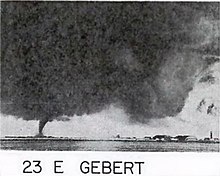
Early in the century, the automobile industry flourished, and in 1905, Fargo became home to the Pence Automobile Company, a company that at one time distributed 29% of all Buicks.[13] In addition, Fargo also hosted a regional Ford assembly plant, which by 1917 was assembling some 70 cars per day. The plant would remain in operation until 1956.[14][15]
On Labor Day in 1910, Theodore Roosevelt visited Fargo to lay the cornerstone of the college's new library.[16] To a crowd of 30,000, Roosevelt spoke about his first visit to Fargo 27 years earlier, and credited his experience homesteading in North Dakota for his eventual rise to the presidency.[16]
Fargo-Moorhead boomed after World War II, and the city grew rapidly despite a violent F5 tornado in 1957 that destroyed a large part of the north end of the city. Ted Fujita, famous for his Fujita tornado scale, analyzed pictures of the Fargo tornado, helping him develop his ideas for "wall cloud" and "tail cloud." These were the first major scientific descriptive terms associated with tornadoes.[17][18] The construction of two interstates (I-29 and I-94) revolutionized travel in the region and pushed growth of Fargo to the south and west of the city limits. In 1972, the West Acres Shopping Center, the largest shopping mall in North Dakota, was constructed near the intersection of the two Interstates. This mall became a catalyst for retail growth in the area.[19]
Recent history
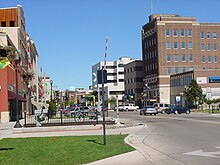
Fargo has continued to expand rapidly but steadily. Since the mid-1980s, the bulk of new residential growth has occurred in the south and southwest zones of the area (for example in West Fargo) due to geographic constraints on the north side.[20] The city's major retail districts on the southwest side have likewise seen rapid development.
Downtown Fargo has been gentrified due in part to investments by the city and private developers in the Renaissance Zone.[21] Most older neighborhoods, such as Horace Mann, have either avoided decline or been revitalized through housing rehabilitation promoted by planning agencies to strengthen the city's core.
NDSU has grown rapidly into a major research university and forms a major component of the city's identity and economy.[22] Most students live off-campus in the surrounding Roosevelt neighborhood. The university has established a presence downtown through both academic buildings and apartment housing. In addition, NDSU Bison Football has gained a significant following among many area residents. In recent years, Fargo has also become a regional technology and healthcare hub, as a result of Microsoft and Sanford Health both building regional campuses in the city center.[23]
Since the late 1990s, the Fargo-Moorhead Metropolitan Statistical Area has consistently had one of the lowest unemployment rates among MSAs in the United States.[24]
On July 14, 2023, 37-year-old Mohamad Barakat opened fire on a group of police officers in the city who were responding to an unrelated traffic accident. One officer was killed and two others were injured before Barakat was killed by one of the officers at the scene.[25]
Geography
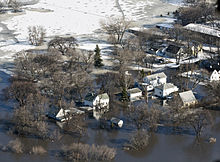
Fargo is a core city of the Fargo-Moorhead, ND–MN Combined Statistical Area, which also includes Moorhead, West Fargo, and Dilworth and outlying communities.
Fargo sits on the western bank of the Red River of the North in a flat geographic region known as the Red River Valley. The Red River Valley resulted from the withdrawal of glacial Lake Agassiz, which drained away about 9,300 years ago. The lake sediments deposited from Lake Agassiz made the land around Fargo some of the richest in the world for agricultural uses.[26][27]
Seasonal floods due to the rising water of the Red River, which flows from the United States into Lake Winnipeg in Manitoba, Canada, have presented challenges. The Red flows northward, which means melting snow and river ice, as well as runoff from its tributaries, often create ice dams causing the river to overflow. Fargo's surrounding Red River Valley terrain is essentially flat, leading to overland flooding. Since the potentially devastating 2009 Red River flood, both Fargo and Moorhead have taken great strides in flood protection; only a near-record flood would cause concern today. Work on the FM Diversion has begun and upon completion, it will permanently floodproof the metro for 500-year floods.
Its location makes the city vulnerable to flooding during seasons with above-average precipitation. The Red River's minor flood stage in Fargo begins at a level of 18 feet, with major flooding categorized at 30 feet and above. Many major downtown roadways and access to Moorhead are closed off at this level. Record snowfalls late in 1996 led to flooding in 1997, causing the Red to rise to a record crest of 39.5 feet, nearly overtaking city defenses. In 2008–2009, significant fall precipitation coupled with rapid snowmelt in March 2009 caused the Red to rise to a new record level of 40.84 feet, but again Fargo remained safe, in large part due to flood mitigation efforts instituted after the 1997 event and sandbagging efforts by the city residents. Further upgrades were made to city infrastructure and additional resources brought to bear following the 2009 flood, which caused no issues for the city in 2010 despite another rapid melt that caused the Red to rise to 37 feet (which ranks among the top-ten highest levels ever recorded). The estimated $1.5 billion FM diversion project is under construction and will channel the Red's water away from the city. As of 2012, Fargo has bought 700 houses in flood-prone areas.[28]
According to the United States Census Bureau, the city has an area of 48.82 square miles (126.44 km2), all land.[29]
Climate
Because of its location in the Great Plains and its distance from both mountains and oceans, Fargo has an extreme humid continental climate (Köppen Dfb, bordering on Dwb), featuring long, bitterly cold winters and warm to hot, humid summers. It lies in USDA Plant hardiness zone 4a.[30] The city features winters among the coldest in the contiguous United States; the coldest month of January has a normal mean temperature of 9.2 °F (−12.7 °C). There is an annual average of 43 days with a minimum of 0 °F (−18 °C) or lower.[31] Snowfall averages 51.4 inches (131 cm) per season.[31] Spring and autumn are short and highly variable seasons. Summers have frequent thunderstorms, and the warmest month, July, has a normal mean temperature of 70.7 °F (21.5 °C); highs reach 90 °F (32 °C) on an average of 12.7 days each year.[31] Annual precipitation of 24.0 inches (610 mm) is concentrated in the warmer months. Record temperatures have ranged from −48 °F (−44 °C) on January 8, 1887, to 114 °F (46 °C) on July 6, 1936; the record coldest daily maximum is −29 °F (−34 °C) on January 22, 1936, while, conversely, the record warmest daily minimum was 82 °F (28 °C), set four days after the all-time record high.[32] On average, the first and last dates to see a minimum at or below the freezing mark are September 30 and May 8, respectively, allowing a growing season of 144 days.[31]
In 2011, Fargo won The Weather Channel's "America's Toughest Weather City" poll. After almost 850,000 votes, blizzards, cold, and floods secured the title for the city.[33]
| Climate data for Fargo, North Dakota (Hector Int'l), 1991–2020 normals,[a] extremes 1881–present[b] | |||||||||||||
|---|---|---|---|---|---|---|---|---|---|---|---|---|---|
| Month | Jan | Feb | Mar | Apr | May | Jun | Jul | Aug | Sep | Oct | Nov | Dec | Year |
| Record high °F (°C) | 55 (13) |
66 (19) |
80 (27) |
100 (38) |
104 (40) |
104 (40) |
114 (46) |
106 (41) |
102 (39) |
97 (36) |
74 (23) |
65 (18) |
114 (46) |
| Mean maximum °F (°C) | 39.8 (4.3) |
42.0 (5.6) |
57.5 (14.2) |
78.3 (25.7) |
88.9 (31.6) |
92.4 (33.6) |
92.9 (33.8) |
92.2 (33.4) |
89.7 (32.1) |
79.5 (26.4) |
59.4 (15.2) |
42.6 (5.9) |
95.8 (35.4) |
| Mean daily maximum °F (°C) | 18.2 (−7.7) |
22.7 (−5.2) |
36.3 (2.4) |
54.1 (12.3) |
68.7 (20.4) |
78.1 (25.6) |
82.1 (27.8) |
80.7 (27.1) |
72.0 (22.2) |
55.8 (13.2) |
38.1 (3.4) |
24.0 (−4.4) |
52.6 (11.4) |
| Daily mean °F (°C) | 9.2 (−12.7) |
13.4 (−10.3) |
27.2 (−2.7) |
43.0 (6.1) |
56.6 (13.7) |
66.8 (19.3) |
70.7 (21.5) |
68.8 (20.4) |
60.0 (15.6) |
45.5 (7.5) |
29.5 (−1.4) |
15.7 (−9.1) |
42.2 (5.7) |
| Mean daily minimum °F (°C) | 0.2 (−17.7) |
4.1 (−15.5) |
18.1 (−7.7) |
31.9 (−0.1) |
44.4 (6.9) |
55.6 (13.1) |
59.4 (15.2) |
56.8 (13.8) |
48.1 (8.9) |
35.2 (1.8) |
20.9 (−6.2) |
7.5 (−13.6) |
31.8 (−0.1) |
| Mean minimum °F (°C) | −22.8 (−30.4) |
−18.8 (−28.2) |
−7.4 (−21.9) |
15.9 (−8.9) |
29.1 (−1.6) |
42.4 (5.8) |
47.3 (8.5) |
44.4 (6.9) |
31.7 (−0.2) |
19.6 (−6.9) |
1.3 (−17.1) |
−15.1 (−26.2) |
−25.0 (−31.7) |
| Record low °F (°C) | −48 (−44) |
−47 (−44) |
−34 (−37) |
−13 (−25) |
14 (−10) |
28 (−2) |
36 (2) |
32 (0) |
17 (−8) |
−4 (−20) |
−27 (−33) |
−36 (−38) |
−48 (−44) |
| Average precipitation inches (mm) | 0.71 (18) |
0.69 (18) |
1.25 (32) |
1.54 (39) |
3.09 (78) |
4.29 (109) |
3.07 (78) |
2.60 (66) |
2.68 (68) |
2.17 (55) |
0.97 (25) |
0.89 (23) |
23.95 (608) |
| Average snowfall inches (cm) | 10.3 (26) |
8.1 (21) |
9.2 (23) |
4.1 (10) |
0.0 (0.0) |
0.0 (0.0) |
0.0 (0.0) |
0.0 (0.0) |
0.0 (0.0) |
1.2 (3.0) |
6.8 (17) |
11.7 (30) |
51.4 (131) |
| Average precipitation days (≥ 0.01 in) | 8.9 | 7.5 | 7.7 | 8.2 | 11.4 | 11.8 | 9.7 | 8.6 | 8.7 | 8.5 | 7.6 | 10.0 | 108.6 |
| Average snowy days (≥ 0.1 in) | 9.5 | 7.6 | 5.5 | 2.3 | 0.1 | 0.0 | 0.0 | 0.0 | 0.0 | 1.2 | 5.4 | 10.2 | 41.8 |
| Average relative humidity (%) | 73.1 | 74.7 | 76.0 | 65.6 | 60.0 | 66.1 | 66.9 | 66.5 | 69.2 | 68.8 | 75.7 | 76.1 | 69.9 |
| Mean monthly sunshine hours | 140.9 | 153.9 | 212.3 | 241.6 | 283.2 | 303.2 | 350.2 | 313.2 | 231.2 | 178.9 | 113.1 | 107.4 | 2,629.1 |
| Percent possible sunshine | 51 | 53 | 58 | 59 | 61 | 64 | 73 | 71 | 61 | 53 | 40 | 40 | 59
Zdroj:https://en.wikipedia.org?pojem=Fargo,_North_Dakota Text je dostupný za podmienok Creative Commons Attribution/Share-Alike License 3.0 Unported; prípadne za ďalších podmienok. Podrobnejšie informácie nájdete na stránke Podmienky použitia.
Analytika
Antropológia Aplikované vedy Bibliometria Dejiny vedy Encyklopédie Filozofia vedy Forenzné vedy Humanitné vedy Knižničná veda Kryogenika Kryptológia Kulturológia Literárna veda Medzidisciplinárne oblasti Metódy kvantitatívnej analýzy Metavedy Metodika Text je dostupný za podmienok Creative
Commons Attribution/Share-Alike License 3.0 Unported; prípadne za ďalších
podmienok. www.astronomia.sk | www.biologia.sk | www.botanika.sk | www.dejiny.sk | www.economy.sk | www.elektrotechnika.sk | www.estetika.sk | www.farmakologia.sk | www.filozofia.sk | Fyzika | www.futurologia.sk | www.genetika.sk | www.chemia.sk | www.lingvistika.sk | www.politologia.sk | www.psychologia.sk | www.sexuologia.sk | www.sociologia.sk | www.veda.sk I www.zoologia.sk |

